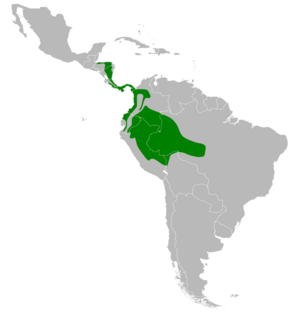Buff-rumped warbler facts for kids
Quick facts for kids Buff-rumped warbler |
|
|---|---|
 |
|
| Conservation status | |
| Scientific classification | |
| Genus: |
Myiothlypis
|
| Species: |
fulvicauda
|
 |
|
| Range of M. fulvicauda | |
| Synonyms | |
|
Basileuterus fulvicauda |
|
The buff-rumped warbler (Myiothlypis fulvicauda) is a small, colorful bird. It belongs to a group called New World warblers. You can find this bird living in places from Honduras in Central America, all the way south to northwestern Peru. It also lives in parts of the western Amazon Rainforest. These birds love to live in forests, especially near water, up to 1500 meters high.
Contents
What Does a Buff-Rumped Warbler Look Like?
The buff-rumped warbler is about 13 to 13.5 centimeters long. That's about the length of your hand! It weighs around 14.5 grams, which is very light.
The main kind of buff-rumped warbler, called M. f. fulvicauda, lives in the western Amazon. It has a dark olive-brown back and a grey head. It has a buff-colored stripe above its eye. The most special part is its bright buff-colored rump and upper tail. This is how the bird got its name! The lower part of its tail is blackish. Its belly is whitish, with some buff on the sides. Both male and female birds look similar. Young birds are a bit browner and have a lighter rump.
Different Kinds of Buff-Rumped Warblers
There are five other types, or subspecies, of the buff-rumped warbler. They are all a little bit different:
- M. f. semicervina: This one lives from eastern Panama to northwestern Peru. It's like the main type, but its buff tail area is bigger and lighter. It also has more buff on its sides.
- M. f. motacilla: Found in the Magdalena Valley in Colombia. It's similar to semicervina, but its buff tail area is even paler, and its back is more olive.
- M. f. leucopygia: This type lives on the Caribbean side of Central America. It's quite unique! It has a much paler buff rump, a white stripe above its eye, dark legs, and dark spots on its chest.
- M. f. veraguensis: You can find this one on the Pacific side of Central America. It's like leucopygia, but it has fewer spots and a slightly darker rump.
- M. f. significans: This type lives in southeastern Peru and northern Bolivia. Its buff rump is not as big as the other types, and its back is olive.
Home and Family
Buff-rumped warblers build their nests on a sloping bank, usually right next to a stream or a path. Their nest is big and shaped like a dome, with an opening on the side. The female bird lays two white eggs. She sits on the eggs for about 16 to 17 days to keep them warm. After the chicks hatch, they stay in the nest for another 13 to 14 days before they are ready to fly.
What Do They Eat?
These warblers mostly eat insects, spiders, and other small invertebrates. They find their food on the ground or catch it while flying. They like to hunt in open areas along stream banks, near puddles, or on roadsides and tracks. A pair of warblers will protect their feeding area along a stream all year long.
Sounds of the Warbler
The buff-rumped warbler makes a hard tschik sound when it calls. The male bird's song is a pretty warble, followed by 8 to 15 ringing chew notes. Sometimes, the female will sing a soft reply.
How Do They Behave?
This bird is quite common and easy to spot. You'll often see it hopping on the ground. It constantly pumps and swings its wide tail, which is a fun behavior to watch!


